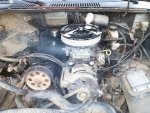psyc0tic1
Member
- Joined
- Feb 6, 2017
- Messages
- 6
- Transmission
- Automatic
hi all,
I have an 87 ranger with the 2.0 manual transmission POS I got in trade for a 4 wheeler. My boy wanted it and once I put a starter and solenoid on it I got it started. Was missing on cylinder 1 and rough idle and stalling.
Checked it out and no compression on #1. Pulled head and the #1 piston was burnt so I replaced the piston. The rest of the motor looked real new and the head looked good with no burnt valves or cracks I could find.
The timing belt cover was missing so getting the cam and crank in time was a bitch. Still not sure it is exactly right but assuming it is at this time.
After putting a new muffler and fuel pump on it I got it running again only to have terrible idle and stalling still (but running on all cylinders).
After reading much on the aisan 2 barrel carbs like the one on this truck I decided I would swap it out for a better one. I bought a holley 2100 (2300?) 2 barrel that was used on early motorcraft cars and made an adapter plate (since there is no such thing in existence on the planet to buy).
Got her up and running again only to find it runs exactly the same as with the original carb. All vacuum lines plugged off except for the distributor and new wires run for the electric choke I installed in place of the exhaust heater one. Major vacuum leak at the intake for the choke so even though it is a bad idea... plugged off the choke housing intake to stop the vacuum leak for testing purposes.
I sprayed everywhere looking for vacuum leaks and never noticed any idle changes.
I could get the truck to idle smooth for a while and then it would just start idling rough again. When I try to drive it, it seems to be very sluggish and act like it doesn't want to run.
I was able to get it to run better by almost closing the choke plate on it because I figured it was getting too much air as if the carburetor was too high of a CFM carb.
I am a bit lost here. I have worked on cars for 27 years and never found one so difficult to diagnose.
I have attached a picture of the completed assembly. I know it doesn't show anything but I could really use some advise/help.
Thank you very much in advance.
I have an 87 ranger with the 2.0 manual transmission POS I got in trade for a 4 wheeler. My boy wanted it and once I put a starter and solenoid on it I got it started. Was missing on cylinder 1 and rough idle and stalling.
Checked it out and no compression on #1. Pulled head and the #1 piston was burnt so I replaced the piston. The rest of the motor looked real new and the head looked good with no burnt valves or cracks I could find.
The timing belt cover was missing so getting the cam and crank in time was a bitch. Still not sure it is exactly right but assuming it is at this time.
After putting a new muffler and fuel pump on it I got it running again only to have terrible idle and stalling still (but running on all cylinders).
After reading much on the aisan 2 barrel carbs like the one on this truck I decided I would swap it out for a better one. I bought a holley 2100 (2300?) 2 barrel that was used on early motorcraft cars and made an adapter plate (since there is no such thing in existence on the planet to buy).
Got her up and running again only to find it runs exactly the same as with the original carb. All vacuum lines plugged off except for the distributor and new wires run for the electric choke I installed in place of the exhaust heater one. Major vacuum leak at the intake for the choke so even though it is a bad idea... plugged off the choke housing intake to stop the vacuum leak for testing purposes.
I sprayed everywhere looking for vacuum leaks and never noticed any idle changes.
I could get the truck to idle smooth for a while and then it would just start idling rough again. When I try to drive it, it seems to be very sluggish and act like it doesn't want to run.
I was able to get it to run better by almost closing the choke plate on it because I figured it was getting too much air as if the carburetor was too high of a CFM carb.
I am a bit lost here. I have worked on cars for 27 years and never found one so difficult to diagnose.
I have attached a picture of the completed assembly. I know it doesn't show anything but I could really use some advise/help.
Thank you very much in advance.














